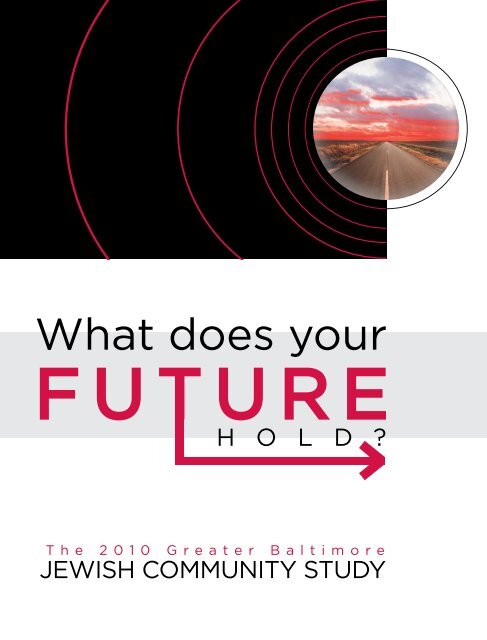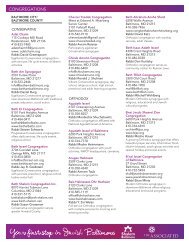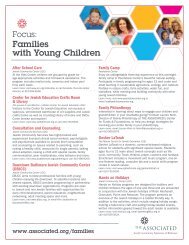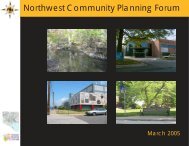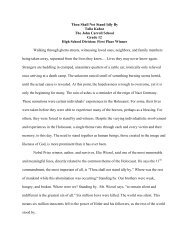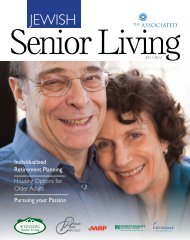what does your - The Associated
what does your - The Associated
what does your - The Associated
You also want an ePaper? Increase the reach of your titles
YUMPU automatically turns print PDFs into web optimized ePapers that Google loves.
<strong>what</strong> <strong>does</strong> <strong>your</strong>F utuReh o l d ?t he 2010 Greater Baltimorejewish community study
What <strong>does</strong> <strong>your</strong> future hold?AN INTRODUCTION<strong>The</strong> 2010 Greater Baltimore Jewish Community Study is a snapshot of JewishBaltimore. Overall, the study shows Baltimore’s Jewish community to be stablewith a high level of Jewish engagement. Yet, it likewise tells stories of decliningrates of participation in Jewish life by a growing minority, especially youngeradults. <strong>The</strong> study shows evolving social and human welfare needs and familiesfacing deep financial challenges that arose out of the economic downturn thatbegan in 2008.Within this executive summary, you will find the highlights and key trends thatour community leadership and researchers have identified. We encourage youto read the full report so that you can draw <strong>your</strong> own conclusions and use thedata to inform the community’s planning and programming efforts. That way wecan all work together to identify significant challenges and opportunities, andproactive responses. That will ensure the continued vibrancy of the BaltimoreJewish community.THE ASSOCIATED: Jewish Community Federation of Baltimore commissionedthis survey by professional researchers who worked under the supervision of adiverse group of communal lay and professional leaders. It will serve as the basisfor THE ASSOCIATED’s planning over the next decade, but it is also a gift to allthe organizations and institutions that serve the Jewish community of Baltimore.<strong>The</strong> study provides us all with facts that we can rely on as we plan together fora stronger and more engaged Jewish community built on solid and moreresponsive institutions.1
Cutting-Edge Methodology andINNOVATIVE STRUCTURE<strong>The</strong> 2010 Baltimore Jewish Community Study employed the latest statisticaltechniques. Almost 10,000 households answered a two-to-three minute “screener,”which determined whether there was an adult in the household who self-identifiedas Jewish. With more than 1,200 randomized surveys of Jewish householdscompleted, the results are reliable and representative of our community.• This is the first U.S. Jewish community study to include cell phone interviews,enabling us to reach more young adults.• This is the first U.S. Jewish community study to report on the impact of theeconomic downturn.How many Jews live inBALTIMORE?42,500 Jewish households (+16% since 1999)A Jewish household is a household that includes at least one self-identifiedJewish adult.93,400 Jewish persons (+2% since 1999)A Jewish person is an adult over the age of 18 who considers him/herself Jewishor a child being raised as Jewish.108,000 persons living in Jewish households (+8% since 1999)This number includes all persons – Jewish and non-Jewish adults, and Jewishchildren and children who are not being raised as Jewish – who are living in ahousehold with at least one self-identified Jewish adult.2
• Downtown has 4,500 Jewish persons living in 3,700 Jewish households.• Guilford/Roland Park has 4,100 Jewish persons living in 2,500 Jewish households.• Using the 1999 geography definitions, the combined Pikesville/Mt. Washingtonarea grew slightly in terms of Jewish persons (8%) and households (7%) since thelast Jewish community study in 1999. <strong>The</strong> number of Park Heights householdsincreased by 11 percent and the number of Jewish persons grew by 25 percent.Owings Mills had the same number of Jewish households, but a 17 percentdecrease in the number of Jewish persons.W h o i s i n J e w i s hBALTIMORE?In general, the Baltimore Jewish community is well-distributed among the differentage cohorts.• Children – 24%• Younger adults (18-34) – 20%• Maturing adults (35-49) – 15%• Boomer Generation (50-64) – 22%• Older adults (65 and over) – 19%Our community is diverse in birthplace and affiliation.• Nearly half of all adults in Jewish Baltimore households were born outsideof Baltimore.• <strong>The</strong> fastest growing part of our population is the Orthodox community, nowmaking up 32 percent of Jewish people.• Roughly one-quarter of Baltimore’s Jews are Conservative.• Twenty-three percent of Baltimore’s Jews are Reform.• Thirteen percent said they were secular or non-denominational.4
Baltimore enjoys relatively high measures ofJEWISH ENGAGEMENT.Data indicate that the Baltimore Jewish community has a relatively highpercentage of people affiliated with a synagogue or other Jewish organization,as well as a relatively high level of attachment to Israel, compared to most otherJewish communities. Baltimore also has a relatively low intermarriage rate, thoughwe are starting to see shifts in these behavioral patterns.• Seventy-four percent of respondents say being Jewish is very importantto them.• Forty-six percent of households report belonging to a synagogue, comparedto 52 percent in 1999. Almost six in 10 households belong to a Jewishorganization.• Only five percent of all respondents report that they are considering movingout of the Baltimore area.• Attachment to Israel and in-marriage is high in comparison to other Jewishcommunities.But, a growing minority of the Jewish community is nothighly engaged in JEWISH LIFE.While the community study findings reported that a significant number of Jewishhouseholds are somehow engaged with our organized Jewish community, nearly halfof all respondents reported feeling that our Jewish organizations are “remote” and/or“not relevant,” including 80 percent of secular or non-denominational respondents.• Only 14 percent of non-Orthodox 18-34-year-olds feel it is very important tobe part of a Jewish community, compared with 43 percent of non-Orthodoxrespondents over the age of 35.5
• Two-thirds of non-Orthodox newcomers do not feel connected to the Jewishcommunity.• Intermarried households are feeling especially disengaged from the Jewishcommunity: 30 percent of children in intermarried homes are being raised Jewishonly. Intermarried families are also unlikely to belong to a synagogue, contributeto a Jewish charity, be attached to Israel or enroll their children in Jewish earlychildhood programs.Cost inhibits participation in Jewish life, especially forthose families earning under $50,000 A YEAR.Thirty-two percent of respondents report that cost is a barrier to synagogueparticipation, Jewish education, Jewish summer camp and travel to Israel.• Synagogue membership is lowest for non-Orthodox households earningunder $50,000.• <strong>The</strong> costs of Jewish education are a significant barrier for households withchildren and incomes below $50,000. This includes Jewish pre-school, dayschool, Jewish overnight summer camp and travel to Israel.6
Orthodox Jews are increasing in number, highly engagedin Jewish life and have differences in lifestyle comparedto their NON-ORTHODOX COUNTERPARTS.<strong>The</strong>re has been a greater than 50 percent increase in the number of OrthodoxJews in Baltimore since 1999 (32 percent of the Jewish population in 2010 versus21 percent in 1999). Many of those Jews are children, as Orthodox households arelarger than other Jewish households.• <strong>The</strong> majority of Orthodox Jews live in the Park Heights corridor. That area is theonly area to have increased in both the number of Jews and the numberof Jewish households since 1999.• Close to 90 percent of Orthodox newcomers feel connected to their community.• Eighty-seven percent of Orthodox respondents under 35 are married, comparedwith 15 percent of Jewish respondents under 35 who are not Orthodox.Important social service ISSUES EXIST.A significant portion of Baltimore Jews reported seeking help for some type ofsocial or human service need.• Twenty-three percent of Jewish households report seeking help in coping withproblems such as depression, anxiety, stress or relationship issues.• Twenty-one percent of Jewish households with a child report seeking help for alearning disability.• Twelve percent of Jewish households report needing assistance in finding a job.7
Many Jews are just managing and/or are livingIN OR NEAR POVERTY.As a result of the economic downturn, one in three respondents (as opposedto one in five 10 years ago) reported that their households are “just managing,”including some who “cannot make ends meet.” Twelve percent of Jewishhouseholds have incomes below 200 percent of the federal poverty standard of$37,000 for a family of three.• Sixty-four percent of Jewish single-parent households are just managing orcannot make ends meet.• Twenty-seven percent of Jewish seniors living alone have incomes that are below200 percent of the federal poverty standard.• Forty-three percent of Jewish households report they were negatively impactedby the economic downturn. This includes households that reported a loss in job(18%), a reduction in salary or income or someone who took a lower paying job.Seniors continue to be a population with SIGNIFICANT NEEDS.<strong>The</strong> community study found a larger and increasing population of Jewish seniorsover the age of 85 than in 1999, an estimated 3,900 in 2010 compared with 1,500 in1999 – a 166 percent increase.• Forty percent of seniors over the age of 65 who are living alone are in poor orfair health.• Twenty-two percent of all Jewish seniors over the age of 65 who are living aloneneed assistance with “activities of daily life.”8• While two-thirds of Baltimore Jewish seniors over the age of 65 report havingan adult child in the area with whom they are in relatively frequent contact,one-third of seniors do not have an adult child living in the Baltimore area.
THE 2010 GREATER BALTIMORE LEADERSHIPMichael SaxonChair, Jewish Community StudyBruce SholkChair of the BoardSandy ShapiroVice-chair, Jewish CommunityStudyMarc B. TerrillPresidentTHE 2010 GREATER BALTIMORE JEWISH COMMUNITY STUDY MANAGEMENT TEAMDr. Gary E. ApplebaumShoshana S. CardinGenine Macks FidlerDr. Nancy Kohn-RabinMark NeumannMichael SaxonSandy ShapiroBruce SholkFred WolfTHE 2010 GREATER BALTIMORE JEWISH COMMUNITY STUDY STEERING COMMITTEEDr. Gary E. ApplebaumCatherine G. ApplefeldDr. Emile BenditAlan Bernstein, Jr.Rabbi Nina B. CardinShoshana S. CardinDavid D. CarlinerGenine Macks FidlerKen GelulaBarbara GradetDr. Nancy Kohn-RabinHerschel LangenthalEllen MacksIra H. MalisRichard P. ManekinSusan B. MannMark NeumannBuddy SapolskyAnnette G. SaxonMichael SaxonRabbi Steven SchwartzSandy ShapiroLee ShermanBruce SholkRabbi Ronald ShulmanHerb SwerenDr. Paul VolosovDebra S. WeinbergFred WolfLawrence M. ZifferTHE ASSOCIATED COMMUNITY PLANNING & ALLOCATIONS PROFESSIONAL TEAMMichael HoffmanRenee DainHannah Pollack-FeilerMary HaarRuth MillerMaayan JaffeKate Valdez<strong>The</strong> 2010 Greater Baltimore Jewish Community Study was funded by anonymous,restricted grants and administered by THE ASSOCIATED: Jewish Community Federationof Baltimore.Study conducted by Ukeles Associates, Inc.Jacob B. Ukeles, Ph.D., PresidentRon Miller, Ph.D., Vice President, ResearchBenjamin Fink, Operations ManagerSurvey research conducted by Social Science Research SolutionsDavid Dutwin, Ph.D., Vice President and Chief MethodologistRobyn Rapoport, Research DirectorTHE ASSOCIATEDJewish Community Federation of Baltimore101 West Mount Royal AvenueBaltimore, MD 21201410-727-4828www.associated.org/<strong>your</strong>future


